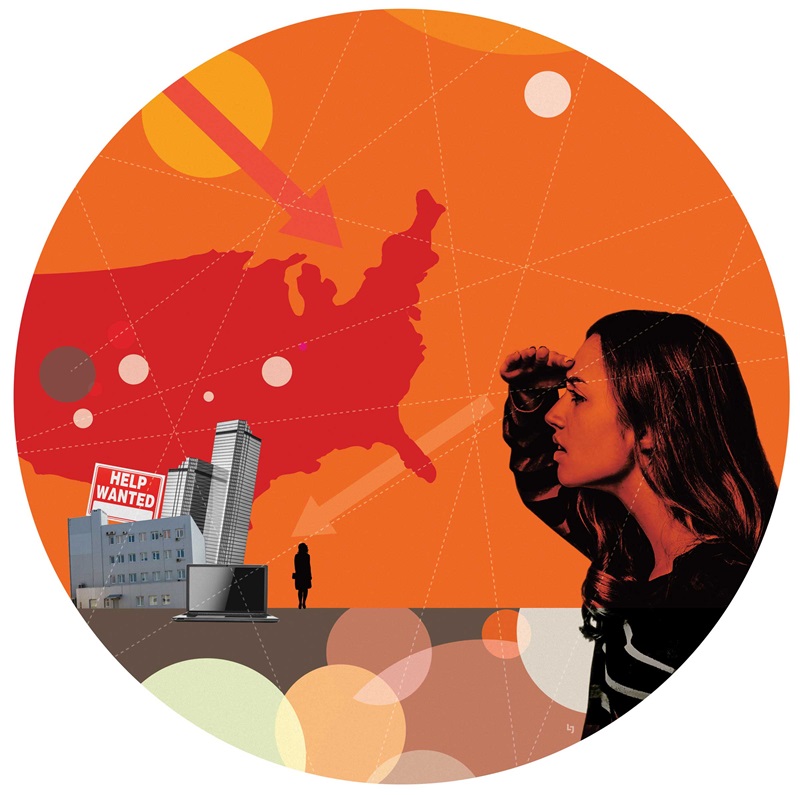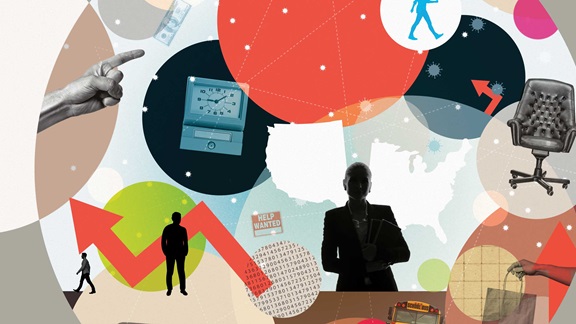Big economic moments deserve a proper name. Some have labeled this one “the great reallocation.”
Another way to put it: COVID shook up our economy like a snow globe. Workers and businesses are not gliding gently back to their old positions: Work environments, job responsibilities, child care, life priorities—all have been set swirling by the pandemic experience.
Even in the before-times, the process for employees and employers to find the right fit was an ordeal for both sides. Researching, applying, and negotiating take effort and time, oftentimes unfruitful. Unlike most markets, in which just one side of a transaction is making a choice (consumers care which restaurant they eat at; restaurants do not generally care which consumers eat there), the labor market is complicated by “two-sided differentiation,” said University of Minnesota labor economist and former Institute visiting scholar Aaron Sojourner: Employers and workers both size up each other, and either can scuttle the deal if the match isn’t right.
The employment process is naturally full of frictions, which Sojourner defines as anything “that gets between you and the best job out there for you.” The term “frictional unemployment” refers to the inevitable share of people who are navigating this matchmaking process.
The extreme signals from the data tell us the labor market is in a high-friction moment. Last year saw a record 47 million people quit their jobs, the highest since the Bureau of Labor Statistics started collecting the data in 2000. Meanwhile, the number of people who have taken themselves out of the labor force remains elevated, particularly for people over age 55.
At the same time, there have been an extraordinary number of job openings, nearly 11 million at the end of 2021—more than the number of people looking for work. The Beveridge Curve shifted outward into unknown territory and took on an unfamiliar vertical shape (see figure): Unemployment stopped falling while openings continued to rise. This imbalance is driving up wages, particularly for lower-wage jobs. That there are so many job openings and so many job seekers implies there are matches to be made. That they aren’t happening, or aren’t happening quickly, suggests that frictions, old and new, are getting in the way.
What do these unusual trends say about how the labor market itself has changed? What do they say about us, as workers? What is the endgame of the great reallocation? Understanding is critical for the Federal Reserve as it sets policy to support the conditions for reaching maximum employment. Yet with labor demand and labor supply adapting to the COVID economic shakeup, one with no recent precedent, it can be tricky to answer that eternal, nagging question: Are we there yet?
You can’t fire me—I quit!
Quitting has been having a moment.
Quits tend to naturally rise with tight job markets. But “they’re not just high,” said economist Steven Davis of the University of Chicago Booth School of Business. “They’re higher than any period in the history of the data.”
The reasons for this churn are likely both structural—where will the swirling snowflakes fall?—and informational—how long will it take them to land? Structurally, the pandemic introduced major health concerns, changed consumer spending patterns, and altered firms’ use of technology, all of which have impacted which businesses are more and less productive—AMC Theatres versus Netflix, say, or a restaurant with a large dining room versus a takeout counter. As a result, “there’s another firm out there now that is more productive and can make better offers” to prospective employees, Sojourner said.

But how people learn about these new opportunities depends upon “information frictions”—the fact that information about job openings, employer quality, and even wages is not easily or equally available. Research by Institute visiting scholar and University of California, Berkeley economist Benjamin Schoefer shows that people don’t seem to have a good sense about how their compensation compares to workers in similar jobs at other employers—whether you are paid well or poorly compared to your peers, you likely think you’re close to the middle.
“If you get stuck in a low-wage job, you might think all jobs are low-wage jobs and therefore you never switch,” Schoefer said. But if these workers are pushed to search for new jobs—as many who were laid off or left their jobs during the COVID recession did—they learn, which may lead them to seek out and obtain higher wages in the future.
In addition, Schoefer’s research suggests, people appear to gain valuable new information about employment options when colleagues quit to look for a new job. As a result, in the near term at least, quitting seems to beget more quitting—a kind of multiplier effect. “One of the top things in the news—and in everyday conversation—is people talking about, ‘Oh, wow, employers are really bidding up wages and a lot of people are quitting their jobs,’” said Nick Bunker, director of economic research for the Indeed Hiring Lab. “People might sort of say, ‘Wait a minute—let me think about this.’”
Power to the people?
In the quits-rate and other aspects of the tight, post-pandemic labor market, it is tempting to see a shift in power from employers to employees. “I do think what we’re seeing right now is a tilting of the bargaining table more toward workers,” said Bunker. “There’s more power for job-seekers because of the kind of outside options they have. If you’re an employed person…you can go to your current employer and say, ‘Hey, look, there’s all this demand out there and all these people are quitting their jobs. It’d be a shame if I left!’”

Household savings surged during the pandemic, thanks to government stimulus and lower household spending. The feeling of extra money in the bank could provide a temporary wealth effect, empowering and emboldening workers.
The increased bargaining power of workers may be short-lived, however, especially where automation (essentially, substituting capital for people) is an option. Ironically, the pandemic itself—and the higher wages that resulted—will tip the scales in favor of automation, predicts economist Andra Ghent of the University of Utah’s David Eccles School of Business.
“This technology was available prior to the pandemic, but for firms it wasn’t cost-effective to invest in it. And now it is,” Ghent said. “Long term, this is not good news” for many lower-wage workers.
Rethinking our relationship to work
Wages are not the only piece of our work lives that the pandemic put in relief.
Most obviously, the pandemic caused a newfound awareness of health risks on the job. “It turns out to be hard to fill a number of jobs that require daily or intensive contact with others,” said economist Arie Kapteyn of the Center for Economic and Social Research at the University of Southern California, which runs the ongoing Understanding Coronavirus in America survey. Health risk is mediated not only by interaction with others but also by employer decisions: Have they put a mask mandate or a vaccine mandate in place? These concerns add to the criteria that job seekers and prospective employers must match on, increasing job search frictions.
But health concerns are not the only driver of new expectations, Kapteyn noted. “Another story is that people are reevaluating their lives: Is this really what you want to do?”
Many already-tough jobs were made more unpleasant by the pandemic, said RAND economist Kathryn Anne Edwards. Hospitality workers have had to enforce mask mandates. Retail workers do more cleaning. Restaurant staff spend time bagging take-out orders (for lower tips) and contend with surly customers. Nurses, bus drivers, substitute teachers … the altered nature of many jobs may lead workers to hold out for alternatives.
In addition, a “status quo” effect may be at work among the historically large number of people who have been out of work for an extended time, explained behavioral economist George Loewenstein of Carnegie Mellon. “Continuing to work in an occupation is very different from re-entering it,” he said. “Being out of it might give you a new perspective on alternatives that life has to offer—possibly with one alternative being idle or unemployed.”
Loewenstein worries about a darker effect of pandemic unemployment, with long-term consequences for the job market: “I suspect that there is a massive mental health crisis that we’re not fully aware of.” Even before the pandemic, Loewenstein said, going back to work after an extended absence “was a very daunting prospect for a lot of people—a lot of insecurity about whether they had the right skills. The pandemic has led to this re-entry issue on a mass scale.”
For some, living through the pandemic has shifted the place of work and earnings in our priorities. By introducing more family time and life without a commute, the pandemic could have altered the value people place on leisure, said Ghent, who studies work-from-home trends. We are more willing to step onto a different path, “willing to say, long-term, maybe this isn’t going to increase my wages as much, but I won’t put myself on the same trajectory to have the big increase in productivity later on [in my career].”
Commuting and cubicles? No, thank you.
People did more than change their minds during the pandemic. They changed ZIP codes.
Some workers moved to an entirely different metro area—leaving California’s Bay Area, for example, in hopes of a remote-working life in Boise. A more substantial shift was the movement away from city centers into the suburbs. While renters are more mobile than homeowners, physical moves are not quickly undone, leaving a sticky situation where jobs and workers are not in the same places as office work returns.
“What might have looked like an attractive job when I only had a 20-minute commute, now doesn’t look so attractive if it’s a 75-minute commute,” noted Davis of the University of Chicago. He says the “spatial mismatch” works both ways, with employees in the suburbs who don’t want to go into the city and city-dwellers finding that service jobs have followed white-collar workers into the suburbs.
For jobs with a remote-work potential, the dance between employers and workers is far from over. The pandemic was a historic inflection point—similar, said the University of Utah’s Ghent, to the telephone or email reaching critical mass. “These technologies have this characteristic of a network externality, where the benefit of them depends upon how many other people are using them,” Ghent said. “Zoom was not invented in 2020. But it wasn’t appropriate for an accountant to say to a client, ‘Hey, you want to just meet over Zoom?’”
Ghent believes the productivity gains from crossing this threshold—including eliminating hours of nonproductive commuting time—will be a “win-win” for workers and employers overall. The University of Minnesota’s Aaron Sojourner points out that it could also reduce job search frictions, allowing both workers and companies to search nationally, not just locally, which should increase the quality of employee-employer matches.
But for this to happen, employees and employers must strike a truce on the right amount of work-from-home. Davis’ ongoing Survey of Working Arrangements and Attitudes finds employee and employer expectations are converging, but workers still expect a nearly full day more at home each week, on average, than employers. Nearly 40 percent of recent, college-educated job-quitters, surveyed in the fall, said they did so to obtain greater time working from home.
One economic diagnosis for the mismatch in expectations: Some diffuse and long-term benefits to office-time for the organization—innovation, collaboration, mentoring—do not factor into workers’ day-to-day calculations of costs and benefits. Loewenstein, the behavioral economist, suggests workers might also be ignoring long-term benefits to themselves, which he labels an “internality” problem.
“These kinds of changes occur slowly within organizations,” Davis said. “It requires a profound shift in how you manage the organization, how you cultivate cultural values, how you transmit knowledge from more-experienced to less-experienced workers.” We are still in the thick of experimenting, bargaining, and self-sorting our way to a new equilibrium around remote work.

A hard(er) bargain
With workers dreading a commute and eager to preserve newfound work-life balance, negotiating a pay and benefits package just got more complicated. Wage bargaining is already prone to frictions caused by asymmetric information; by the fact that negotiation typically happens only annually; and by the practical reality that wages are hard to adjust downward.
Now the pandemic has introduced a new element into the compensation picture. Employees and job seekers want flexibility; but at what cost? Davis’ ongoing Survey of Working Arrangements and Attitudes finds employees now working from home part of the week would require a raise of more than 8 percent to compensate them for returning to the office full time.
Post-COVID inflation adds another wrinkle—but also a possible solution to the stickiness of wage decreases. “Smart employers can probably get away for the next couple of years with offering lower wage increases than they might otherwise offer,” said Davis. “It’ll be a lot easier to get away with a wage hike below the inflation rate, if you at the same time allow workers to work from home part of the week.”
Remote work is not an option for all jobs, of course. In particular, many lower-wage jobs in retail, hospitality, and manufacturing must be done on site. These are jobs at which workers traditionally have little negotiating power over wages; they have also experienced anemic wage growth over the past 20 years. Now, however, wages in a number of low-wage sectors are the fastest-growing in the economy. These jobs cannot be compensated with greater flexibility, and in many cases the job responsibilities carry both new risks and burdens. By not accepting the old, low rates of pay, workers are exerting influence to increase wages.
The child care challenge
Flexible hours and hybrid work help keep parents in the labor force. But trying to juggle work and children during the pandemic has proven they are no substitute for reliable child care.
Child care has long been a friction for parents of young children, especially mothers, affecting both whether and how much they work, RAND’s Edwards said. With limited access to paid family leave, subsidized child care, or part-time work schedules, “We haven’t made it easy for mothers of young children to work in the formal labor market,” said Elizabeth Cascio, an economics professor at Dartmouth College.
When the pandemic sent not just young children but all children home, “in terms of the time parents had to devote to these child care needs, it was almost like having another newborn,” observed Gema Zamarro, professor of economics and education reform at the University of Arkansas. Mothers were far more likely than fathers to provide this care, even when both parents were employed, according to Zamarro’s analysis of survey data: In the spring of 2020, one in three working moms reported being the sole provider of child care for their children, compared to one in 10 working dads. And this imbalance had grown even larger by fall 2020.
But the days didn’t get any longer. “Being the only one providing child care in the spring of 2020 is associated with a 20 percentage-point increase in respondents saying, ‘I had to reduce working hours,’” Zamarro reported, and sole providers were also more likely to transition out of employment entirely. Research by Edwards shows that the more kids there are in a household, the larger the decline in mothers’ labor force participation.
Unfortunately, child care frictions stoked by the pandemic remain elevated. The child care sector is roughly 10 percent smaller than it was before, Cascio reports—and as many parents can attest, availability was a challenge even in 2019. Lower supply, compounded with post COVID approaches to cleaning and crowding, will tend to make child care even more expensive than the $15,000-$20,000 that quality centers typically cost before the pandemic. Schools have reopened, but children are still subject to unpredictable quarantines and closures.
And while most working parents feel a child care crunch, the burden doesn’t fall evenly. Ultimately, parents with greater resources are better able to solve their child care needs, stay in the labor force, be more productive, earn more money, and invest more in their children, U.S. Census Bureau economist Misty Heggeness explained, making affordable, accessible child care an equality issue. (See “The Great Balancing Act.” )
With some 10 million open jobs, it’s also a matter of economic growth. Speaking to CBS’s “Face the Nation” about the challenge of finding child care, Minneapolis Fed President Neel Kashkari said, “It does have an effect on women’s participation in the labor force and how high our labor force participation is as a whole.”
Like the tug-of-war over remote work, workers’ willingness to quit, and our shifting relationship to our jobs, “These [child care] challenges have been exacerbated in the pandemic,” Kashkari said. “Long term, this is an important economic growth issue and competitiveness issue for the country.”
This article is featured in the Spring 2022 issue of For All, the magazine of the Opportunity & Inclusive Growth Institute
Lisa Camner McKay is a senior writer with the Opportunity & Inclusive Growth Institute at the Minneapolis Fed. In this role, she creates content for diverse audiences in support of the Institute’s policy and research work.
Jeff Horwich is the senior economics writer for the Minneapolis Fed. He has been an economic journalist with public radio, commissioned examiner for the Consumer Financial Protection Bureau, and director of policy and communications for the Minneapolis Public Housing Authority. He received his master’s degree in applied economics from the University of Minnesota.







